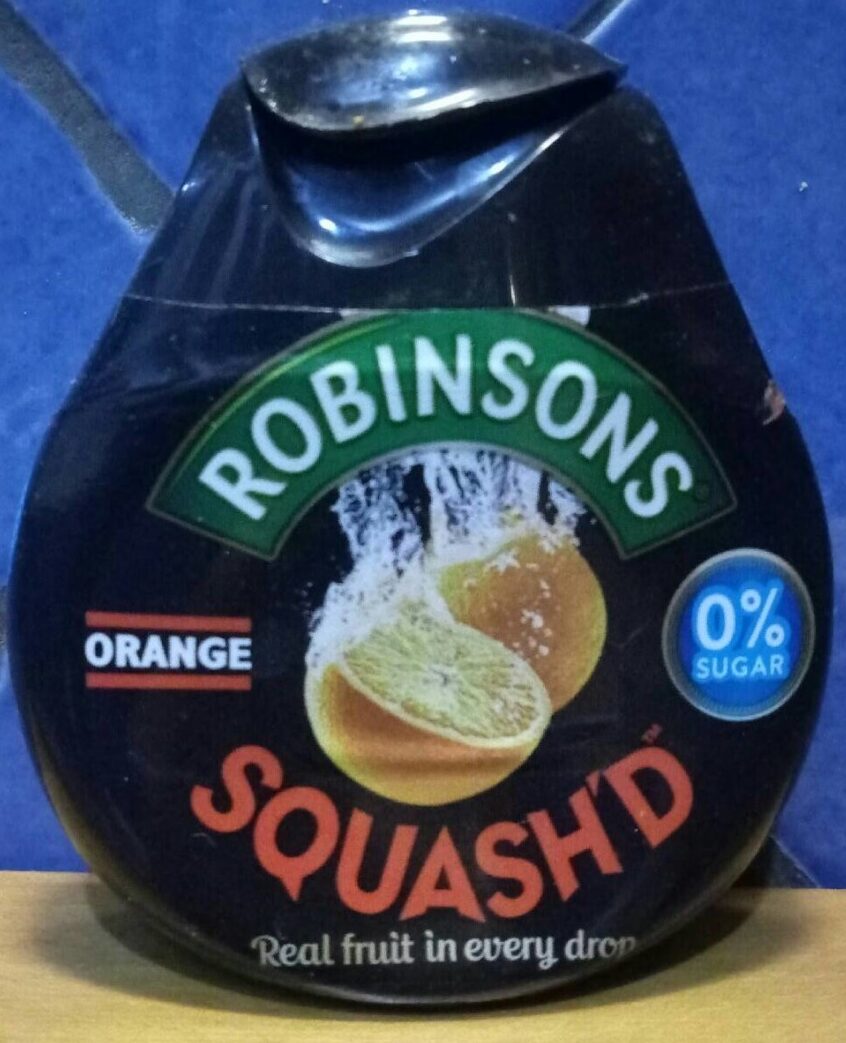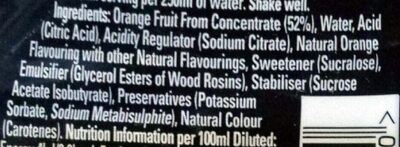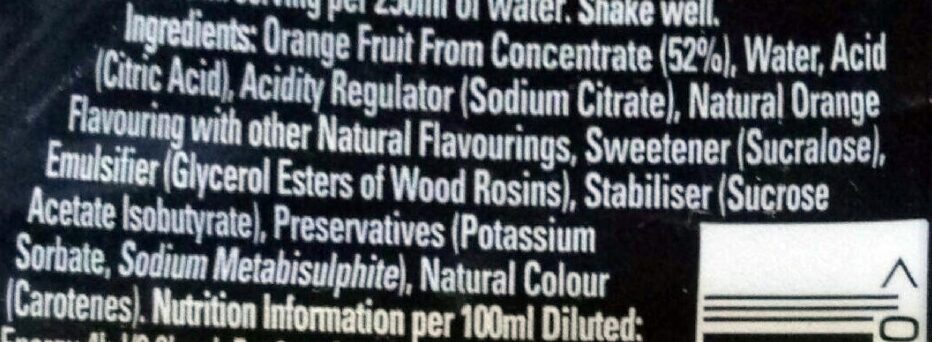Ajuda'ns a fer que la transparència alimentària sigui la norma!
Com a organització sense ànim de lucre, depenem de les vostres donacions per continuar informant els consumidors de tot el món sobre tot allò què mengen.
La revolució alimentària comença amb tu!
Squash'd orange - Robinsons
Squash'd orange - Robinsons
Aquesta pàgina del producte no està completa. Podeu ajudar a completar-la editant-la i afegint-hi més dades a partir de les fotos ja disponibles, o fent-ne més amb l'aplicació de androide o iPhone / iPad. Gràcies!
×
Codi de barres: 50413980
Marques: Robinsons
Categories: Aliments i begudes amb base vegetal, Begudes, Begudes amb base vegetal, Begudes amb base de fruites, Sucs i nèctars, Nèctars de fruita, en:Orange nectars
Països on es va vendre: Espanya
Matching with your preferences
Salut
Ingredients
-
20 ingredients
: Orange Fruit From Concentrate (52%), Water, Acid (Citric Acid), Acidity Regulator (Sodium Citrate), Natural Orange Flavouring with other Natural Flavourings, Sweetener (Sucralose), Emulsifier (Glycerol Esters of Wood Rosins), Stabiliser (Sucrose Acetate Isobutyrate), Preservatives (Potassium Sorbate, Sodium Metabisulphite), Natural Colour (Carotenes). Nutrition Information per 100ml Diluted: 0¹
Processament d'aliments
-
Aliments ultra processats
Elements que indiquen que el producte està al grup 4 - Aliments i begudes ultraprocessats:
- Additiu: E160a - Carotè
- Additiu: E444 - Acetat isobutirat de sacarosa
- Additiu: E445 - Èster glicèrid de la colofònia de fusta
- Additiu: E955 - Sucralosa
- Ingredient: Color
- Ingredient: Emulsionant
- Ingredient: Edulcorant
Els productes alimentaris es classifiquen en 4 grups segons el seu grau de processament:
- Aliments no processats o mínimament processats
- Ingredients culinaris processats
- Aliments processats
- Aliments ultra processats
La determinació del grup es fa en funció de la categoria del producte i dels ingredients que conté.
Additius
-
E160a - Carotè
Carotene: The term carotene -also carotin, from the Latin carota, "carrot"- is used for many related unsaturated hydrocarbon substances having the formula C40Hx, which are synthesized by plants but in general cannot be made by animals -with the exception of some aphids and spider mites which acquired the synthesizing genes from fungi-. Carotenes are photosynthetic pigments important for photosynthesis. Carotenes contain no oxygen atoms. They absorb ultraviolet, violet, and blue light and scatter orange or red light, and -in low concentrations- yellow light. Carotenes are responsible for the orange colour of the carrot, for which this class of chemicals is named, and for the colours of many other fruits, vegetables and fungi -for example, sweet potatoes, chanterelle and orange cantaloupe melon-. Carotenes are also responsible for the orange -but not all of the yellow- colours in dry foliage. They also -in lower concentrations- impart the yellow coloration to milk-fat and butter. Omnivorous animal species which are relatively poor converters of coloured dietary carotenoids to colourless retinoids have yellowed-coloured body fat, as a result of the carotenoid retention from the vegetable portion of their diet. The typical yellow-coloured fat of humans and chickens is a result of fat storage of carotenes from their diets. Carotenes contribute to photosynthesis by transmitting the light energy they absorb to chlorophyll. They also protect plant tissues by helping to absorb the energy from singlet oxygen, an excited form of the oxygen molecule O2 which is formed during photosynthesis. β-Carotene is composed of two retinyl groups, and is broken down in the mucosa of the human small intestine by β-carotene 15‚15'-monooxygenase to retinal, a form of vitamin A. β-Carotene can be stored in the liver and body fat and converted to retinal as needed, thus making it a form of vitamin A for humans and some other mammals. The carotenes α-carotene and γ-carotene, due to their single retinyl group -β-ionone ring-, also have some vitamin A activity -though less than β-carotene-, as does the xanthophyll carotenoid β-cryptoxanthin. All other carotenoids, including lycopene, have no beta-ring and thus no vitamin A activity -although they may have antioxidant activity and thus biological activity in other ways-. Animal species differ greatly in their ability to convert retinyl -beta-ionone- containing carotenoids to retinals. Carnivores in general are poor converters of dietary ionone-containing carotenoids. Pure carnivores such as ferrets lack β-carotene 15‚15'-monooxygenase and cannot convert any carotenoids to retinals at all -resulting in carotenes not being a form of vitamin A for this species-; while cats can convert a trace of β-carotene to retinol, although the amount is totally insufficient for meeting their daily retinol needs.Origen: Wikipedia (Anglès)
-
E202 - Sorbat de potassi
Potassium sorbate: Potassium sorbate is the potassium salt of sorbic acid, chemical formula CH3CH=CH−CH=CH−CO2K. It is a white salt that is very soluble in water -58.2% at 20 °C-. It is primarily used as a food preservative -E number 202-. Potassium sorbate is effective in a variety of applications including food, wine, and personal-care products. While sorbic acid is naturally occurring in some berries, virtually all of the world's production of sorbic acid, from which potassium sorbate is derived, is manufactured synthetically.Origen: Wikipedia (Anglès)
-
E223 - Metabisulfit de sodi
Sodium metabisulfite: Sodium metabisulfite or sodium pyrosulfite -IUPAC spelling; Br. E. sodium metabisulphite or sodium pyrosulphite- is an inorganic compound of chemical formula Na2S2O5. The substance is sometimes referred to as disodium metabisulfite. It is used as a disinfectant, antioxidant, and preservative agent.Origen: Wikipedia (Anglès)
-
E330 - Acid citric
Citric acid: Citric acid is a weak organic acid that has the chemical formula C6H8O7. It occurs naturally in citrus fruits. In biochemistry, it is an intermediate in the citric acid cycle, which occurs in the metabolism of all aerobic organisms. More than a million tons of citric acid are manufactured every year. It is used widely as an acidifier, as a flavoring and chelating agent.A citrate is a derivative of citric acid; that is, the salts, esters, and the polyatomic anion found in solution. An example of the former, a salt is trisodium citrate; an ester is triethyl citrate. When part of a salt, the formula of the citrate ion is written as C6H5O3−7 or C3H5O-COO-3−3.Origen: Wikipedia (Anglès)
-
E331 - Citrats de sodi
Sodium citrate: Sodium citrate may refer to any of the sodium salts of citrate -though most commonly the third-: Monosodium citrate Disodium citrate Trisodium citrateThe three forms of the salt are collectively known by the E number E331. Sodium citrates are used as acidity regulators in food and drinks, and also as emulsifiers for oils. They enable cheeses to melt without becoming greasy.Origen: Wikipedia (Anglès)
-
E444 - Acetat isobutirat de sacarosa
Sucrose acetate isobutyrate: Sucrose acetoisobutyrate -SAIB- is an emulsifier and has E number E444. In the United States, SAIB is categorized as generally recognized as safe -GRAS- as a food additive in cocktail mixers, beer, malt beverages, or wine coolers and is a potential replacement for brominated vegetable oil.Origen: Wikipedia (Anglès)
-
E445 - Èster glicèrid de la colofònia de fusta
Glycerol ester of wood rosin: Glycerol ester of wood rosin, also known as glyceryl abietate or ester gum, is an oil-soluble food additive -E number E445-. The food-grade material is used in foods, beverages, and cosmetics to keep oils in suspension in water, and its name may be shortened in the ingredient list as glycerol ester of rosin. It is also used as an ingredient in the production of chewing-gum and ice cream. Similar, less pure materials -glycerol ester of gum rosin- are used as a component of certain low-cost adhesives.To make the glycerol ester of wood rosin, refined wood rosin is reacted with glycerin to produce the glycerol ester. Glycerol ester of wood rosin is an alternative to brominated vegetable oil in citrus oil-flavored soft drinks. In some cases, both ingredients are used together.Origen: Wikipedia (Anglès)
-
E955 - Sucralosa
Sucralose: Sucralose is an artificial sweetener and sugar substitute. The majority of ingested sucralose is not broken down by the body, so it is noncaloric. In the European Union, it is also known under the E number E955. It is produced by chlorination of sucrose. Sucralose is about 320 to 1‚000 times sweeter than sucrose, three times as sweet as both aspartame and acesulfame potassium, and twice as sweet as sodium saccharin. Evidence of benefit is lacking for long-term weight loss with some data supporting weight gain and heart disease risks.It is stable under heat and over a broad range of pH conditions. Therefore, it can be used in baking or in products that require a long shelf life. The commercial success of sucralose-based products stems from its favorable comparison to other low-calorie sweeteners in terms of taste, stability, and safety. Common brand names of sucralose-based sweeteners are Splenda, Zerocal, Sukrana, SucraPlus, Candys, Cukren, and Nevella. Canderel Yellow also contains sucralose, but the original Canderel and Green Canderel do not.Origen: Wikipedia (Anglès)
Anàlisi dels ingredients
-
Pot contenir oli de palma
Ingredients que poden contenir oli de palma: E160a
-
Es desconeix si és vegà
Ingredients no reconeguts: en:orange-fruit-from-concentrate, Citronan sodný, en:natural-orange-flavouring-with-other-natural-flavourings, en:glycerol-esters-of-wood-rosins, en:nutrition-information-per-100ml-diluted, en:0Alguns ingredients no s'han pogut reconèixer.
Necessitem la teva ajuda!
Podeu ajudar-nos a reconèixer més ingredients i analitzar millor la llista d'ingredients d'aquest producte i d'altres mitjançant:
- Editeu aquesta pàgina de producte per corregir les faltes d’ortografia de la llista d’ingredients i/o per eliminar els ingredients d’altres idiomes i frases que no estiguin relacionades amb els ingredients.
- Afegiu entrades, sinònims o traduccions noves a les nostres llistes multilingües d’ingredients, mètodes de processament d’ingredients i etiquetes.
Uniu-vos al canal #ingredients del nostre espai de discussió a Slack i/o apreneu sobre l'anàlisi dels ingredients en la nostra wiki, si voleu ajudar. Gràcies!
-
Es desconeix si és vegetarià
Ingredients no reconeguts: en:orange-fruit-from-concentrate, Citronan sodný, en:natural-orange-flavouring-with-other-natural-flavourings, en:glycerol-esters-of-wood-rosins, en:nutrition-information-per-100ml-diluted, en:0Alguns ingredients no s'han pogut reconèixer.
Necessitem la teva ajuda!
Podeu ajudar-nos a reconèixer més ingredients i analitzar millor la llista d'ingredients d'aquest producte i d'altres mitjançant:
- Editeu aquesta pàgina de producte per corregir les faltes d’ortografia de la llista d’ingredients i/o per eliminar els ingredients d’altres idiomes i frases que no estiguin relacionades amb els ingredients.
- Afegiu entrades, sinònims o traduccions noves a les nostres llistes multilingües d’ingredients, mètodes de processament d’ingredients i etiquetes.
Uniu-vos al canal #ingredients del nostre espai de discussió a Slack i/o apreneu sobre l'anàlisi dels ingredients en la nostra wiki, si voleu ajudar. Gràcies!
-
Detalls de l'anàlisi dels ingredients
Necessitem la teva ajuda!
Alguns ingredients no s'han pogut reconèixer.
Necessitem la teva ajuda!
Podeu ajudar-nos a reconèixer més ingredients i analitzar millor la llista d'ingredients d'aquest producte i d'altres mitjançant:
- Editeu aquesta pàgina de producte per corregir les faltes d’ortografia de la llista d’ingredients i/o per eliminar els ingredients d’altres idiomes i frases que no estiguin relacionades amb els ingredients.
- Afegiu entrades, sinònims o traduccions noves a les nostres llistes multilingües d’ingredients, mètodes de processament d’ingredients i etiquetes.
Uniu-vos al canal #ingredients del nostre espai de discussió a Slack i/o apreneu sobre l'anàlisi dels ingredients en la nostra wiki, si voleu ajudar. Gràcies!
: Orange Fruit From Concentrate 52%, Water, Acid (Citric Acid), Acidity Regulator (Sodium Citrate), Natural Orange Flavouring with other Natural Flavourings, Sweetener (Sucralose), Emulsifier (Glycerol Esters of Wood Rosins), Stabiliser (Sucrose Acetate Isobutyrate), Preservatives (Potassium Sorbate, Sodium Metabisulphite), Natural Colour (Carotenes), Nutrition Information per 100ml Diluted (0¹)- Orange Fruit From Concentrate -> en:orange-fruit-from-concentrate - percent_min: 52 - percent: 52 - percent_max: 52
- Water -> en:water - vegan: yes - vegetarian: yes - ciqual_food_code: 18066 - percent_min: 4.8 - percent_max: 48
- Acid -> en:acid - percent_min: 0 - percent_max: 33.3333333333333
- Citric Acid -> en:e330 - vegan: yes - vegetarian: yes - percent_min: 0 - percent_max: 33.3333333333333
- Acidity Regulator -> en:acidity-regulator - percent_min: 0 - percent_max: 21.6
- Sodium Citrate -> en:sodium-citrate - percent_min: 0 - percent_max: 21.6
- Natural Orange Flavouring with other Natural Flavourings -> en:natural-orange-flavouring-with-other-natural-flavourings - percent_min: 0 - percent_max: 14.4
- Sweetener -> en:sweetener - percent_min: 0 - percent_max: 10.8
- Sucralose -> en:e955 - vegan: yes - vegetarian: yes - percent_min: 0 - percent_max: 10.8
- Emulsifier -> en:emulsifier - percent_min: 0 - percent_max: 8.64
- Glycerol Esters of Wood Rosins -> en:glycerol-esters-of-wood-rosins - percent_min: 0 - percent_max: 8.64
- Stabiliser -> en:stabiliser - percent_min: 0 - percent_max: 7.2
- Sucrose Acetate Isobutyrate -> en:e444 - vegan: yes - vegetarian: yes - percent_min: 0 - percent_max: 7.2
- Preservatives -> en:preservative - percent_min: 0 - percent_max: 6.17142857142857
- Potassium Sorbate -> en:e202 - vegan: yes - vegetarian: yes - percent_min: 0 - percent_max: 6.17142857142857
- Sodium Metabisulphite -> en:e223 - vegan: yes - vegetarian: yes - percent_min: 0 - percent_max: 3.08571428571429
- Natural Colour -> en:natural-colours - percent_min: 0 - percent_max: 5.4
- Carotenes -> en:e160a - vegan: maybe - vegetarian: maybe - from_palm_oil: maybe - percent_min: 0 - percent_max: 5.4
- Nutrition Information per 100ml Diluted -> en:nutrition-information-per-100ml-diluted - percent_min: 0 - percent_max: 4.8
- 0¹ -> en:0 - percent_min: 0 - percent_max: 4.8
Nutrició
-
Falten dades per calcular la Nutri-Score
Falten dades nutricionals
⚠ ️S'han d'especificar les dades nutricionals del producte per calcular el Nutri-Score.Podries afegir la informació necessària per calcular el Nutri-Score? Afegir dades nutricionals
-
Informació nutricional
Informació nutricional Preparat
per 100 g/100 mlComparat amb: en:Orange nectars Energia 4 kj
(0 kcal)Greix 0 g Àcid gras saturat 0 g Hidrats de carboni 0 g Sucre 0 g Fiber 0 g Proteïna 0,05 g Sal comuna ? Fruits‚ vegetables‚ nuts and rapeseed‚ walnut and olive oils (estimate from ingredients list analysis) ?
Entorn
-
Eco-puntuació B - Impacte ambiental baix
El Eco-Score és una puntuació experimental que resumeix els impactes ambientals dels productes alimentaris.→ L'Eco-Score es va desenvolupar inicialment a França i s'està ampliant per a altres països europeus. La fórmula Eco-Score està subjecta a canvis, ja que es millora periòdicament per fer-la més precisa i més adequada per a cada país.Anàlisi del cicle de vida
-
Impacte mitjà dels productes de la mateixa categoria: A (Score: 99/100)
Categoria: Orange nectar
Categoria: Orange nectar
- Puntuació ambiental PEF ( petjada ambiental de l'aliment ): 0.03 (com més baixa sigui la puntuació, menor serà l'impacte)
- incloent l'impacte sobre el canvi climàtic: 0.78 kg CO₂ eq/kg del producte
Etapa Impacte Agricultura
79.6 %Processament
-95.1 %Empaquetament
31.9 %Transport
70.1 %Distribució
13.5 %Consum
0.0 %
Bonificacions i punts negatius
-
Falta informació sobre l'origen dels ingredients
Punts negatius: -5
⚠ ️ L'origen dels ingredients d'aquest producte no està indicat.
Si estan indicats a l'embalatge, podeu modificar la fitxa del producte i afegir-los.
Si sou el fabricant d'aquest producte, podeu enviar-nos la informació amb la nostra plataforma gratuïta per a productors.
-
Falta informació sobre l'embalatge d'aquest producte
Punts negatius: -15
⚠ ️ La informació sobre l'embalatge d'aquest producte no està completada.⚠ ️ Per a un càlcul més precís de l'Eco-Score, podeu modificar la pàgina del producte i afegir-los.
Si sou el fabricant d'aquest producte, podeu enviar-nos la informació amb la nostra plataforma gratuïta per a productors.
Eco-Score per a aquest producte
-
Impacte per a aquest producte: B (Score: 79/100)
Producte: Squash'd orange - Robinsons
Puntuació de l'anàlisi del cicle de vida: 99
Suma de bonificacions i punts negatius: -20
Puntuació final: 79/100
-
Petjada de carboni
-
Equivalent a conduir 0.4 km en un cotxe de gasolina
78 g de CO² per cada 100 g de producte
La xifra d'emissions de carboni prové de la base de dades Agribalyse d'ADEME, per a la categoria: Orange nectar (Font: Base de dades ADEME Agribalyse)
Etapa Impacte Agricultura
9.7 %Processament
44.6 %Empaquetament
12.8 %Transport
31.1 %Distribució
1.9 %Consum
0.0 %
Empaquetament
-
Falta informació sobre l'embalatge d'aquest producte
⚠ ️ La informació sobre l'embalatge d'aquest producte no està completada.Take a photo of the recycling information Take a photo of the recycling information
Transport
-
Orígens dels ingredients
Falta informació sobre l'origen dels ingredients
⚠ ️ L'origen dels ingredients d'aquest producte no està indicat.
Si estan indicats a l'embalatge, podeu modificar la fitxa del producte i afegir-los.
Si sou el fabricant d'aquest producte, podeu enviar-nos la informació amb la nostra plataforma gratuïta per a productors.Add the origins of ingredients for this product Add the origins of ingredients for this product
Report a problem
-
Incomplete or incorrect information?
Category, labels, ingredients, allergens, nutritional information, photos etc.
If the information does not match the information on the packaging, please complete or correct it. Open Food Facts is a collaborative database, and every contribution is useful for all.
Fonts de dades
Producte afegit per kiliweb
Última modificació de la pàgina del producte per aleene.
La pàgina del producte, també editada per thaialagata, yuka.VEpnRVB2Z0l0UDRscXZRZTUwbjYxZjVWbnJ5d1VWMk9MY282SUE9PQ.








